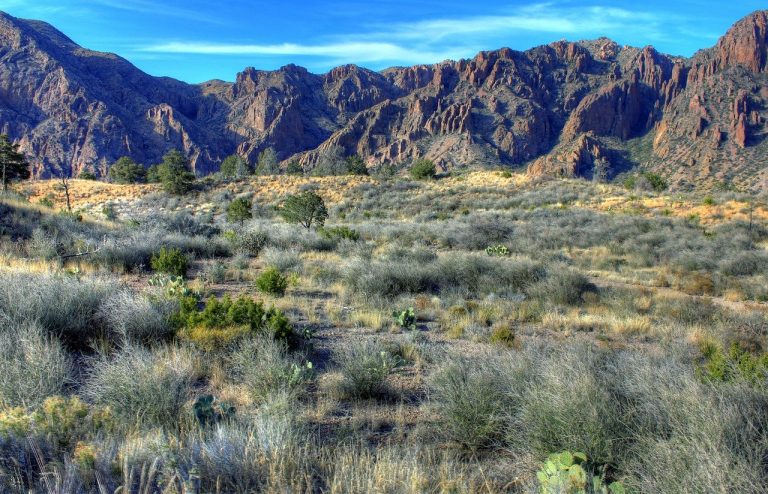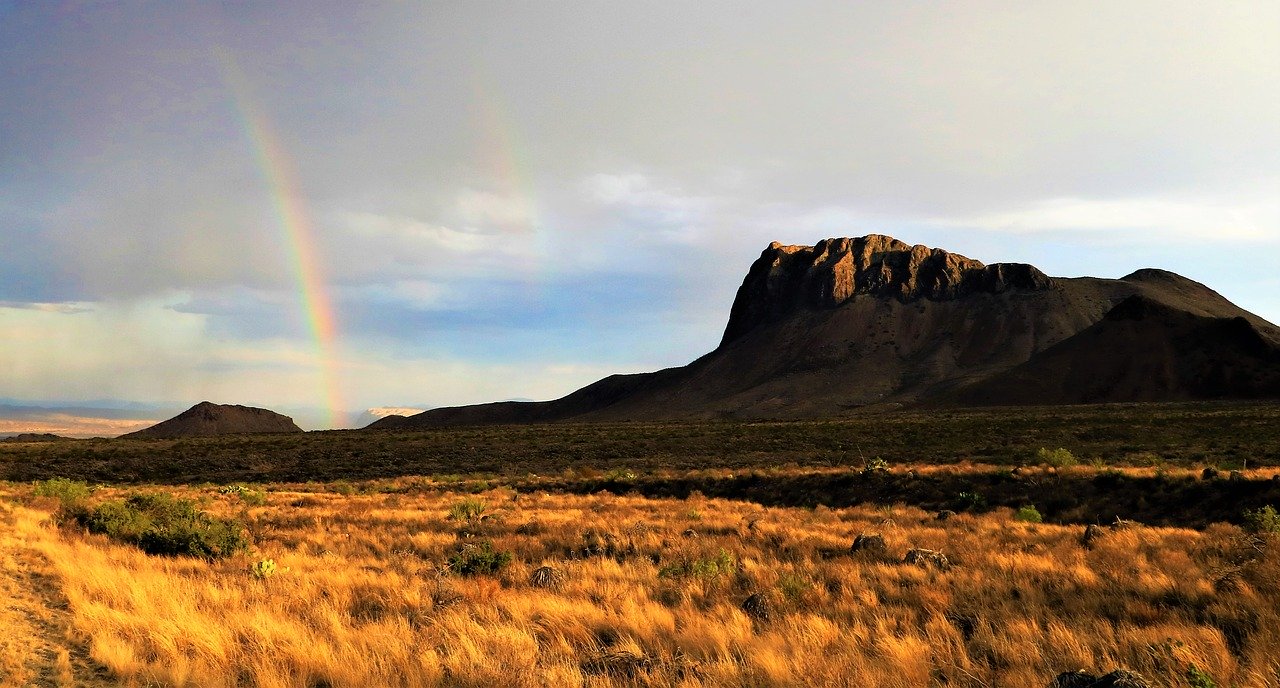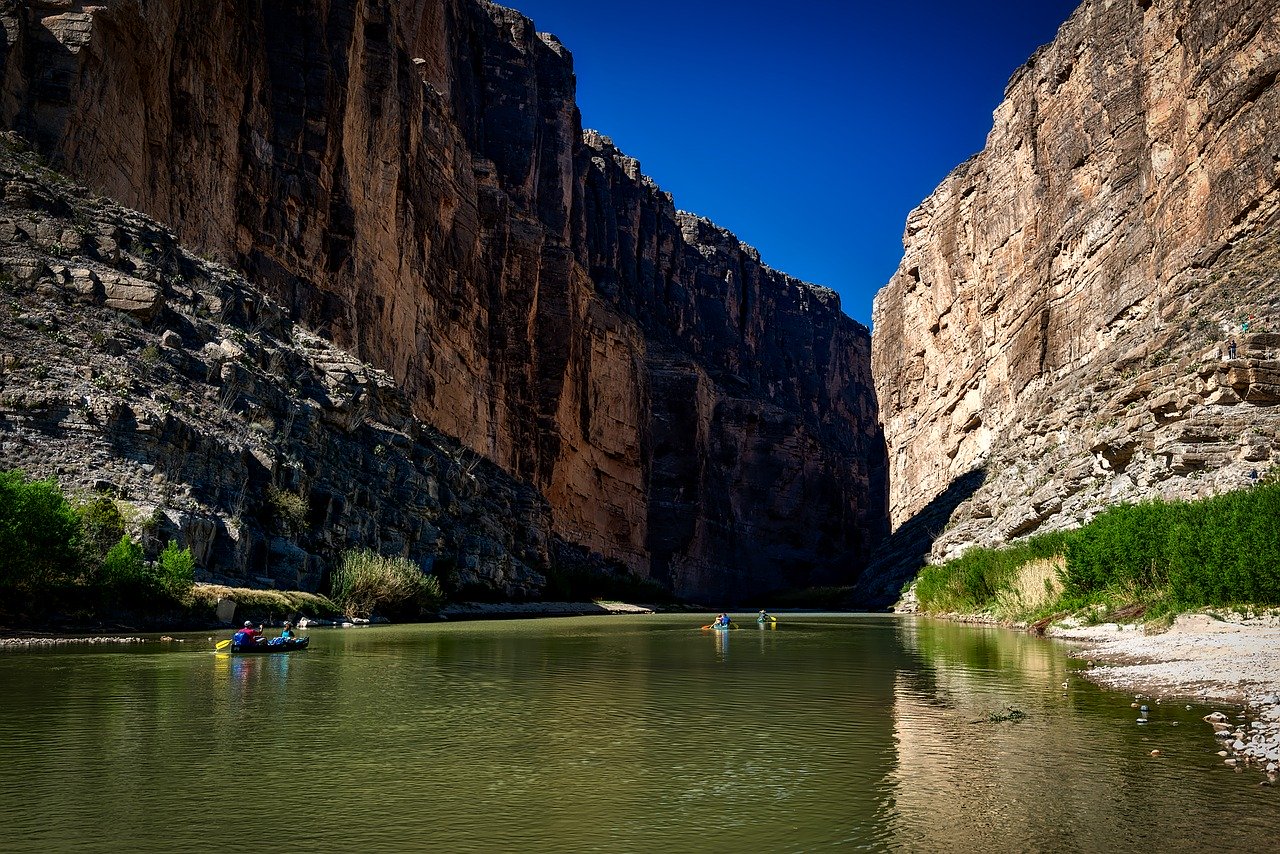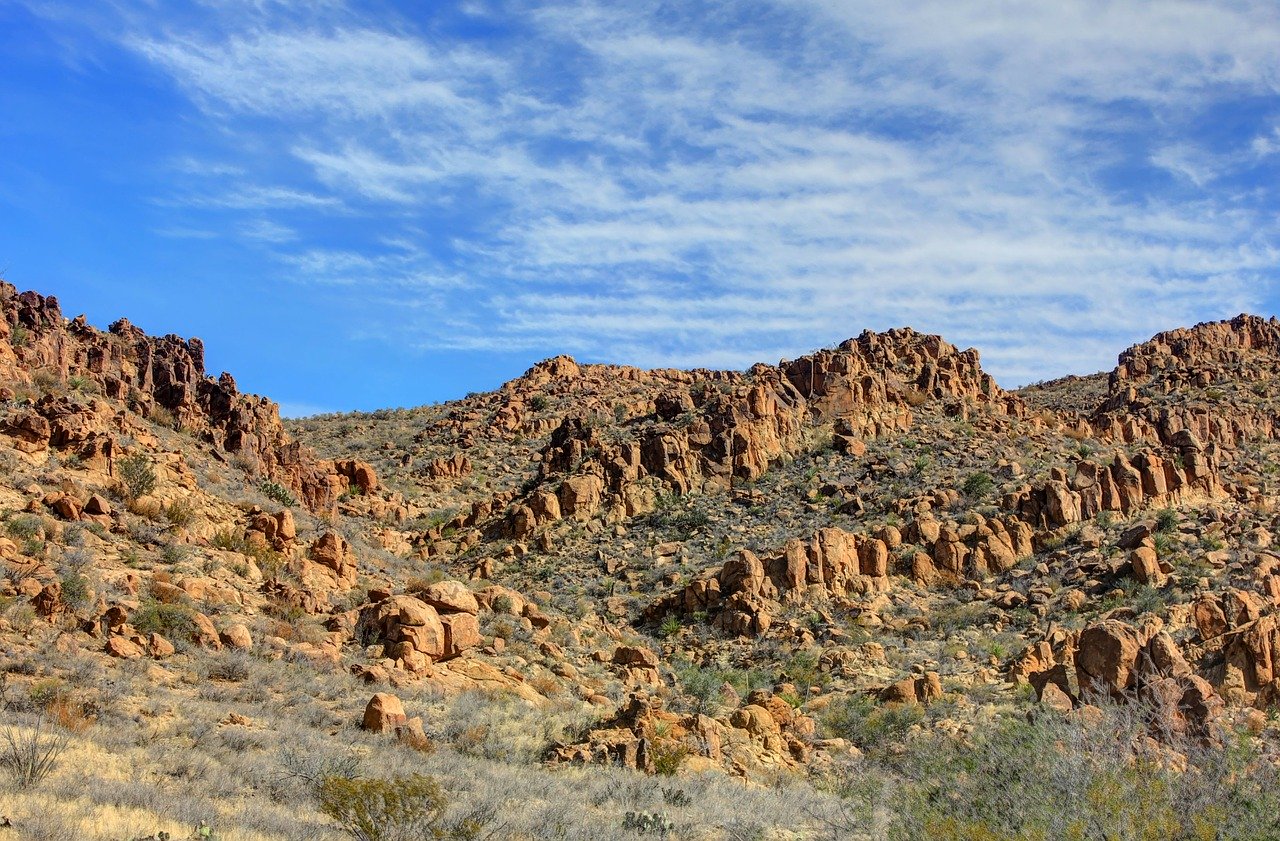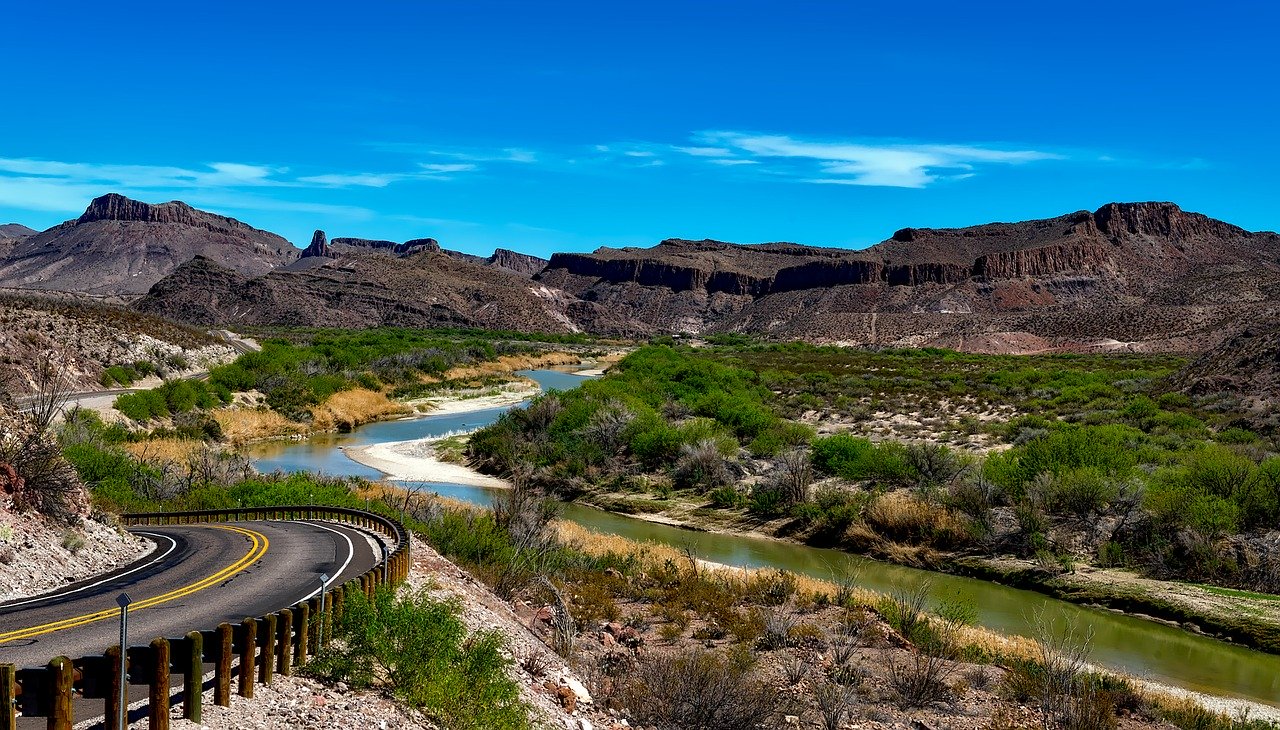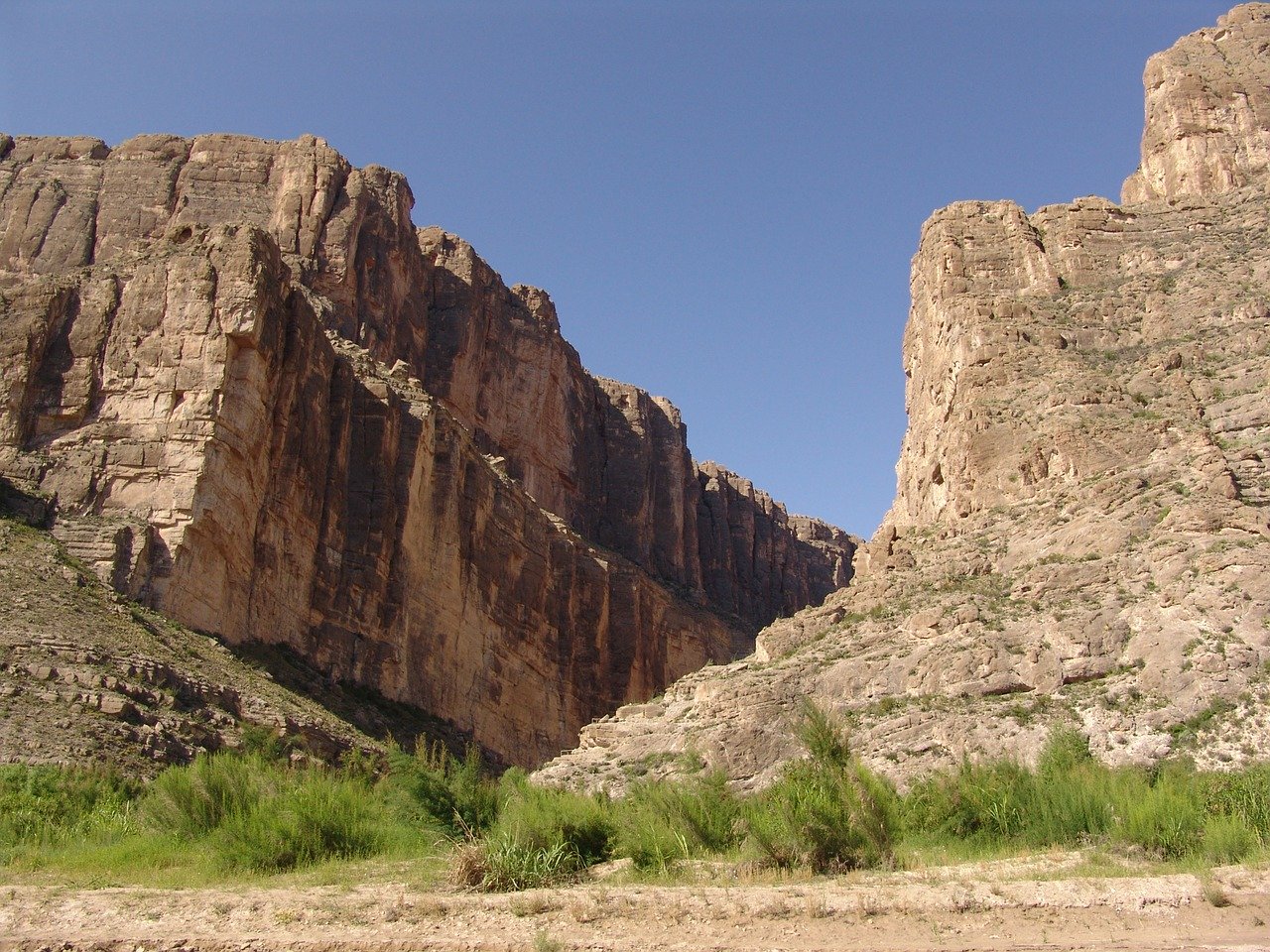There is something incredibly magical and beautiful about camping at Big Bend National Park. You will have an abundance of photo opportunities thanks to the incredible landscape all around. The only things that could compete are the fabulous sunsets and star-lit nights.
There are plenty of adventures to choose from and a wide variety of wildlife to enjoy. If this will be your first time visiting Big Bend National Park, we hope that our guide will give you a helping hand in enjoying the trip of a lifetime.
Big Bend National Park Facts
- On June 12, 1944, Big Bend National Park received the official status of national park.
- It is the prominent bend in the Rio Grande border that gives the park the name Big Bend National Park.
- Within the United States, Big Bend National Park is not only one of the most remote and spacious national parks, it is also one of the ones which gets the least number of visitors. There were only 440,000 people that visited in 2018. Granted, that may sound like a big number but when you compare it to the 4 million visitors that Yellowstone received and the 11 million that Great Smoky Mountain national park had, you see it really isn’t that many!
- In 2012, Big Bend National Park received the designation of International Dark-Sky park, thanks to the remote location it enjoys, as well as the minimal light pollution here. Within the lower 48 states, it is Big Bend National Park that has the darkest skies. One of the most enjoyable things to do here is to gaze up at that incredible night sky.
Where Is Big Bend National Park?
Big Bend National Park is located in West Texas and meets the border with Mexico.
You can take one of several highways to reach Big Bend National Park: TX 118 will take you from Alpine or you can take FM 170 which from Presidio, both of these lead to Study Butte (you will then need to travel 26 miles in an easterly direction to get to the park headquarters), another option is the US 90 it US 385 to Marathon (you will then need to travel 70 miles in a southerly direction to reach the park headquarters).
Big Bend National Park Weather
The park enjoys sunshine nearly all year around.
The months of Spring tend to be warm and are the busiest months for visitors. As Spring Break falls in mid-march you will need to ensure that you already have made accommodation reservations if you come during this time.
The summer months are hot; there can be quite a variance in temperatures from the heat of the desert floor with temperatures often over 100 Fahrenheit and the Chisos Mountains where temperatures can be up to 20 degrees lower. The hottest months are July and August. Visitors during these months need to know about heat safety. From May to Sepmerner the park is in the rainy season and can have flash flooding and thunderstorms. The rains during the latter part of the day are lovely and cooling, making this an excellent time to visit the park.
Fall moves swiftly into Winter and the months are mild and often sunny although freezing cold weather can occur, as well as cloudy days. Snow does not fall often and when it does it tends to be light.
Visitors who come during the winter months need to be prepared for a variety of conditions. If you plan to come during the holiday periods of Thanksgiving or Christmas you should ensure that you make a reservation in advance as these times tend to be busy with visitors.
Best Time To Visit Big Bend National Park
From the start of January until the middle of April is the best time to visit the park. The days are sunny, the nights are cool and the desert is in spectacular full bloom.
The months of May until September are hot and whilst you may be able to camp at Chisos Basin and enjoy the cooler climate, your daytime adventures will be limited as often the temperatures are over 100 Fahrenheit.
Things To Do In Big Bend National Park
Enjoy A Dip In The Hot Springs
Within the Rio Grande Village, one of the most popular activities is the 105-degree Fahrenheit natural hot springs that are found at the edge of the Rio Grande. A quick plunge into the river will cool you off if you are feeling too warm.
You will find the primitive pool very close to the parking area if you follow a trail that goes past the pictographs and also by the remains of what was once a resort back in the early 1900s.
Visit The Fossil Discovery Exhibit
Make sure you stop at the Fossil Discovery Exhibit as you make your drive down from Marathon, it is here that you will learn all about the geology of the park. The Exhibit opened in 2017 and has outdoor rooms with displays and information.
The bronze skulls of a large alligator, as well as a Bravoceratops dinosaur, are the stars of the show, as well as the giant pterosaur found on the ceiling of one of the rooms.
Take The Ross Maxwell Scenic Drive
This stunning drive goes through fabulous desert scenery as it travels toward Castalon and the Santa Elena Canyon.
You will enjoy incredible Mountain views that stretch all the way across the Chihuahuan Desert. You can stop at the Homer Wilson Ranch Overlook, not only to admire the old homestead but also to take in a wonderful photo opportunity of a dazzling view.
You can access the Mule Ear Springs trail from the highway, or if you do not feel like doing the actual hike it is possible to see the cores of two ancient volcanoes, known as the twin peaks.
Visit Terlingua Ghost Town
Stopping for a quick bite to eat at Terlingua Ghost Town will give you a taste of life in a small town in West Texas.
You will find a great selection of crafts, jewelry, and souvenirs at the Terlingua Trading Company, one of the largest establishments within the town.
Admire The Sun As It Sets Over The Window
There is a massive V-shaped notch within the side of the mountain that is known as the Window, it frames the sky and distant desert. It is only 0.3 miles from the Chisos Basin Visitor center to the Window and provides a wonderful place to watch the sunset.
Indulge In A Spot Of Bird Watching
Big Bend National Park provides a wonderful place to spot birds as they migrate north or south. The Colima warbler, summer tanagers, water screech owls and rufous crowned sparrows are just a few of the species to keep your eyes peeled for.
The Nature trail found at Rio Grande Village is the perfect spot to see birds, as well as the Cottonwood Campground and the Chisos Mountains.
Have Fun Rafting Or Kayaking
To really appreciate the incredible location, make a reservation to float along the Rio Grande.
There are many rafting and kayaking trips for either a half-day or several days You can enjoy splendid views as you float the Santa Elena, Boquillas or Mariscal canyons and the opportunity of whitewater rafting is always an option.
Book A Horseback Ride To Remember
The backcountry roads here are ideal for horseback riding. Since the park does not allow grazing you need to make sure you bring enough feed and also give thought to water. The park has several stables nearby which provide day or multiday trips and often experience is not needed.
Enjoy The Area By Bike
With more than 100 miles of paved road and 160 miles of dirt roads, cyclists have an abundant choice.
You can cycle 35 miles on the Maxwell Scenic Drive to soak in incredible views, although do be prepared for some steep hills along the way.
Best Hikes In Big Bend National Park
Lost Mine Trail
With 4.8 meters in distance roundtrip, this hike’s trailhead begins at the Basin Road. As you go along this moderate hike, you’ll get to see the picturesque views of the beautiful Casa Grande and Juniper Canyon within the first mile of your hike.
Be prepared for the steep climb and a forest entourage which will then lead you to an overlooking view of the Pine Canyon as well as the Sierra del Carmen in Mexico.
Panther Path
Among all the other paths in the area, this is considered to be the best one for beginners. The trail distance is 50 yards with a trail that’s accessible to a wheelchair. This is perfect for large groups or families who want to enjoy the picturesque view in the area without the physical strain.
You may also obtain your Panther Path brochure if you drop by the visitors’ center. The brochure is great for beginners, giving you an overview of what you’re about to expect, including the available desert flora that you’ll see along the path. The desert flora has both medicinal and cultural significance making it a main point when visiting the said hike trail.
Window View Trail
This trail is often mixed up with the Window Trail hike, but the Window View trail is often great for new hikers and beginners. With a trail that has a nice paved trail accessible for newbies and even those on wheelchairs, it has a 0.3-mile distance with a trailhead beginning at the Chisos Basin.
As you go along the hike, you’ll see multiple views of the various peaks and basins in the surrounding areas. This is also great for families as it has benches as you go along the way, allowing you to even watch the sunset with your loved one.
Mule Ears Spring Trail
With a total distance of 3.8 miles, this moderate trail begins at the Ross Maxwell drive, and as you go through the mountain skirts and foothills, you’ll see around the Trap Mountain.
Throughout the hike, you’ll also pass through some cattail springs surrounded by shrubs, ferns, and other beauties of nature. Bathing is prohibited in the area – but you can pass through to enjoy the scenery and get back to where you’ve started.
South Rim
Ideally, this is best for experienced hikers. This strenuous trail has a 2,000 feet gain from the start to finish with an overall length of about 12 – 14.5 miles, depending on where you’ve decided to ascend.
You may choose to ascend either along the South Rim, or along the Laguna Meadows Trail. Some areas of the trail are inaccessible during the season where falcons are nesting. With that being said, you must check with the park while you’re planning your hiking activity.
Chimneys Trail
Another moderate difficulty trail, this 4.8-mile trail hike starts at Ross Maxwell Scenic Drive, similar to the Mule Ears Spring Trail. Following the trail will lead you to the beautiful volcanic formations that are usually associated with “American southwest” areas.
It’s called chimneys trail because you’ll see visible chimneys, with a little bit of twist at the end of the trail. You can head back to where you’ve started going through the simple route, or take another 7-mile hike that will lead you to a beautiful outdoor experience as you get to pass through some cacti and hoodoos.
Rio Grande Village Nature Trail
A trail that has multiple loops, this short trail gives everyone the chance to get close with wildlife – and great for those who love bird watching.
A 0.75-mile distance hike, this trail has a pavement that’s accessible to wheelchairs at the start of the Rio Grande Village Campground. As you go through it, you’ll experience crossing multiple bodies of water, a bit of climbing in the limestone hill with a picturesque view of the Del Carmen Mountains that’s perfect for sunrise and sunset viewing.
If you want to stay a bit longer, get to experience the expanse, and the beautiful night sky showered with bright twinkling stars.
Santa Elena Canyon Trail
To arrive at the Santa Elena Canyon, you have to cross the Terlingua Creek. From there, get down the steps until you reach the beautiful waters until you reach the canyon.
With a 1.7-mile hike distance, this trail is ideal for beginners with light to moderate physical activities, and get to experience the beautiful views as a reward for the little “stretch” during the hike.
Hot Springs Historic Trail
This trail, while not the most difficult in Big Bend, is said to be more difficult when you do your hike during the summer season. There is less shade, making it difficult for those who aren’t accustomed to the hot weather. Although short, this is a riverside hike so make sure that you’re prepared to get way along the way.
Get to experience passing through multiple spots such as an old and abandoned resort, homestead, some famous hot springs, and pictographs.
Outer Mountain Loop
This is for the serious and experienced hiker who is prepared to spend two nights to complete the trail. If you want to experience the best of the Big bend, this trail is perfect for you.
Take note that you need to acquire your backpacking permit especially for overnight camping. Don’t forget your water as this should be your number one priority if you want to survive the hike.
With a 30-mile hike that’s strenuous (and not ideal for beginners), this hike will complete your experience filled with desert landscapes, lush forest, and a beautiful, yet steep elevation that gives you the best views in the area.
Big Bend National Park Camping
Chisos Basin Campground
Surrounded by a few jagged peaks and sitting on a smallish plateau, the Chisos Basin Campground offers a pretty dramatic setting, at a 5,040 feet elevation. This is a very pleasant place to choose for camping, as the climate is great and the camping grounds are near to many popular hikes in Big Bend National Park.
This campground is home to 60 campsites, with 24 that are reservable. The rest work on a first-come, first-served basis. The sites range from private, where other sites are barely visible, to exposed, meaning that they back onto other sites without any visible separation. Chisos Basin Campground has flush toilets but no showers.
RVs over 24 feet and trailers over 20 feet are discouraged since the roads are narrow and tight. This is mainly a camping ground for tent camping.
Rio Grande Village Campground
Close to the Rio Grande River, this campground is the largest in Big Bend National Park, yet it is still divided up giving it a more intimate feeling.
This campground has 100 sites, with 43 that are reservable. Set on an elevation of 1,850 feet, makes these grounds among the hottest places in this park. This is obviously a drawback in summer, but a benefit in the cooler months.
The facilities at this campground include flush toilets and showers. You can use a generator during daylight hours, but they are not permitted for use after 8 pm.
Rio Grande Village RV Campground
Situated near to the Rio Grande Village Campground, this RV park is a paved narrow and long parking area, with RV sites that line the sides. This parking-lot-style setup is not great, but the scenery that surrounds this area is.
There is a picnic area not far from the RV park and the start point for one of the hikes that take you to hot springs, yet this is definitely not the shortest access point to these hot springs.
The Rio Grande Village RV, run and operated by a company know as Forever Resorts, provides 25-sites with full hookups. 20 of the sites are reservable.
The elevation at this site is 1,800 feet which means the days can get quite hot, which will depend on the time of year. This area also has a store closeby with basic supplies and food.
Cottonwood Campground
For tranquility and nature, Cottonwood Campground is the ideal option. Set in a green and lush area and close to the Rio Grande, you will see all types of critters and birds, from maligned javelinas to vermillion flycatchers.
Cottonwood Campground is home to 24 campsites, that are all non-reservable. Many of the campsites are spacious and set well-apart. There are only pit toilets available when camping here.
Primitive Roadside Campsites In Big Bend National Park
Off the dirt roads, and hidden in several corners of this park, you will find a variety of backcountry campsites. Unlike most parks where hike-in camping means backcountry, this park offers you the opportunity to drive to your very own isolated camping site.
If you are looking to savor the quiet and tranquility of desert nights with a group of friends or family, this is the ideal opportunity. Light pollution is just about non-existent in this park. This is why Big Bend National Park is recognized as one of the designated Dark Sky Parks. On moonless nights, the stars are truly phenomenal.
Keep in mind that there is no water or toilets available, and most sites have no shade. Make sure you travel well-equipped and ensure you bring along a structure for shade.
Maverick Ranch RV Park
Linked to the Lajitas Golf Resort, this is a stunning RV park situated in the scenic setting of the Painted Hills. These camping grounds are 20 miles from the western entrance to Big Bend National Park.
The main advantage of using this RV park includes full access to Lajitas Golf Resort facilities. This includes the pool that is “chilled” for the months of summer and any other activity that the resort offers.
Even though this campsite is mainly an RV park, these camping grounds are also available for tents. With 100 RV sites, with 60 that are pull-through, the rates vary according to length-of-stay and the season. The pricing also varies according to daily, weekly, or monthly rates.
Rancho Topanga Campground
Situated on the western side of Big Bend NP, close to Terlingua, this campground is a tent-only site and a great choice when you are unable to find any other camping spots while visiting the park.
This establishment is family-run and is regarded as one of the best campgrounds outside the borders of the park. Set at the foot of a hillside, these camping grounds are relatively scenic.
Facilities include cold and hot water showers, which is a perk that is not even available in a few of the Terlingua hotels. There is also portable water available for each site, and these camping grounds are pet-friendly.
Rancho Topanga Campground has 25 campsites scattered across a large desert area, with no shade. Make sure you bring a canopy if you plan to spend some of your time at your camping site during daylight hours.
BJ’s RV Park
This area is one of the closest places for RVers to park. Situated on the western side, in Terlingua, this RV park contains 29 sites with full-hookups. It is also able to accommodate RVs of any size.
Some of the amenities include Wi-Fi, showers, and flush toilets. The park is just a desert patch along the roadside, but it is very convenient when you plan on visiting Big Bend National Park.
This park is well-known for low light-pollution, offering dramatic sights of the West Texas night skies. One of the other benefits of this park is the fact that it’s pet-friendly.
Study Butte RV Park
One of the benefits of choosing a spot at this RV park is the convenience of reaching your camping spot within 3 miles from the western entrance of Big Bend NP.
This is a small facility that offers full hookups, Wi-Fi, showers, and a few tent sites. Study Butte RV Park also has its own gift shop and small store, and its also conveniently located across from Cottonwood General Store. This store offers a variety of camping supplies and groceries.
Big Bend Resort and Adventures RV Park
This resort and RV park are around 4-miles from the east entrance into Big Bend National Park, which makes it extremely convenient. The campground is large, so when you cannot find other camping sites, you should find a spot here.
Big Bend National Park also accommodates large rigs, tents, and provides wireless Internet access and full hookups. The parking spaces are unpaved, but the facility is pet-friendly and offers reduced rates on monthly stays.
Big Bend National Park Lodging
When the weather is unpredictable, or the campgrounds have filled up, or maybe you just don’t like camping, there are a few other fantastic options along the edges of this park.
Luxury Hotels
If you coming from the eastern side, it is best to consider Marathon as your base, which is around 40-miles to the north of Big Bend National Park. This is the town that is the closest to the eastern side. The Gage Hotel offers historical luxury rooms. The rooms available in the main part of the lodge feature open beams and wooden ceilings, or one of the tastefully-decorated suites that surround the courtyard. The outdoor pool is really welcoming on hot days.
On the western sides of the Big Bend National Park, the luxury Lajitas Golf Resort is rated as one of the best places to stay. This is a western-themed resort that offers an outdoor pool, an 18-hole golf course, along with an activity center where guests can participate in activities such as horseback riding, canoeing down the Rio Grande, or zip-lining.
Mid-Range Hotels
In Marathon, Eve’s Garden Bed and Breakfast allow for a slightly different experience. This adobe-style, sprawling, fantasy-like inn offers an indoor organic garden which is in bloom throughout the year. Uniquely-decorated rooms and vibrant colors offer a truly experienced-based stay. The common areas include a pond, tea room, and a courtyard, inviting guests to either mingle or relax,
Close to Terlingua, located along the western side of this park, you will find Terlingua Ranch Lodge, which is a 40-minute drive away from Big Bend National Park. The lodge features rustic, remote-style cabins set amidst scenic deserts and mountains providing an opportunity to enjoy stargazing from your own patio or relax around the tranquil pool area. This accommodation is great for anyone looking to escape from the cities and towns. The lodge has a restaurant along with occasional live music.
Alpine
Alpine is the hub of the Big Bend and a major service center. There are about 400 hotel rooms, along with restaurants, shopping and groceries. America’s Best Value Inn, Antelope Lodge and Hampton Inn are some good choices. It is the home of Sul Ross State University, and annual events like Gallery Night and the Cowboy Poetry Gathering. Alpine is 30 miles east of Marathon, and 80 miles north of the western entrance to Big Bend National Park.
- 15 Best Free Online Virtual Summer Camps for Kids (2022) - July 6, 2021
- Expert Roundup: Advice to Mitigate the Effects of Coronavirus - March 22, 2021
- Best Gifts for Travelers - January 15, 2021
